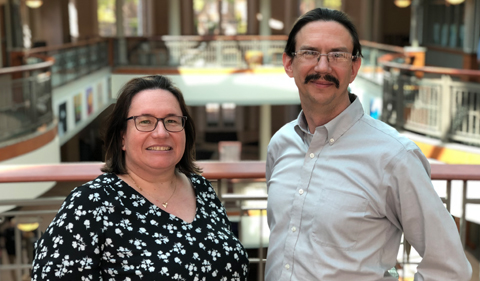Ohio University Physics & Astronomy Associate Professor Julie Roche and Research Assistant Professor Paul King contributed to a 12-year collaborative effort of more than 100 scientists, in an experiment termed “Q-weak,” to provide a precision test of the weak force, one of four fundamental forces in nature.
The group’s breakthrough paper, “Precision measurement of the weak charge of the proton,” recently published in the scientific journal Nature, provides a means to constrain possibilities for new particles and forces beyond our present knowledge.
“Precision measurements like this one can act as windows into a world of potential new particles that otherwise might only be observable using extremely high-energy accelerators that are currently beyond the reach of our technical capabilities,” said Roger Carlini, a scientist and a co-spokesperson for the Q-weak Collaboration at the Department of Energy’s Thomas Jefferson National Accelerator Facility (Jefferson Lab) in Newport News, Virginia.
King served as Analysis Coordinator for the collaboration, and led the group that developed data acquisition and analysis software. Roche advised two OHIO doctoral students whose work directly contributed to the experiment.
“Our understanding of how subatomic particles interact, the standard model of particle physics, has worked very well to describe nearly all observations made to date, but it is incomplete,” explains King.
Theories proposed to build on the Standard Model theory of fundamental particles introduce new particles and forces at energies higher than what has been measured directly so far, motivating the construction of more powerful accelerators, such as the Large Hadron Collider near Geneva, Switzerland.
But, if present, these as-yet-unknown particles would cause tiny changes in the way electrons and protons interact at lower energies. By making a precise measurement of the proton’s weak charge, Q-weak can set limits on the mass of possible new particles at many thousands of times the mass of the proton.
Revealing the Precise Strength of the Weak Force
While the weak force is difficult to observe directly, its influence can be felt in our everyday world. For example, it initiates the chain of reactions that power the sun and it provides a mechanism for radioactive decays that partially heat the Earth’s core and that also enable doctors to detect disease inside the body without surgery.
Now, the Q-weak Collaboration has revealed one of the weak force’s secrets: the precise strength of its grip on the proton. They did this by measuring the proton’s weak charge to high precision, which they probed using the high-quality beams available at the Continuous Electron Beam Accelerator Facility, a DOE Office of Science User Facility.
The proton’s weak charge is analogous to its more familiar electric charge, a measure of the influence the proton experiences from the electromagnetic force. These two interactions are closely related in the Standard Model, a highly successful theory that describes the electromagnetic and weak forces as two different aspects of a single force that interacts with subatomic particles.
Training for Early Career Physicists
Roche and King have been centrally involved in Q-weak since arriving at OHIO in 2006. Together they have included and guided more than a dozen OHIO physics students on the project supported by grants from the National Science Foundation. Two of Roche’s doctoral students, Rakitha Beminiwattha (Ph.D. ’13) and Buddhini Waidyawansa (Ph.D. ’13), are authors on the paper. A third author, Jeong Han Lee, was a postdoctoral researcher with Roche and King at Jefferson Lab.
“Precision measurements are subtle and very delicate, Roche says. “ The precision of our final result basically match what we had envisioned more than ten years ago and this is a tribute to the craft of our collaboration as a whole. We’re so happy the project has come to a successful completion.”

OHIO-affiliated Q-weak Collaboration authors pictured here at Jefferson Lab in front of the Q-weak apparatus include (L to R): Rakitha Beminiwattha (Ph.D.’13 and currently an Assistant Professor at Louisiana Tech University), Buddhini Waidyawansa (Ph.D., ’13) , Julie Roche, Paul King, Jeong Han Lee (currently staff at the European Spallation Source)
Read the full paper “Precision measurement of the weak charge of the proton” in Nature 557, 207-211 (2018), DOI: 10.1038/s41586-018-0096-0
Jefferson Lab is supported by the Office of Science of the U.S. Department of Energy. The Office of Science is the single largest supporter of basic research in the physical sciences in the United States, and is working to address some of the most pressing challenges of our time. For more information, visit science.energy.gov.




















Comments